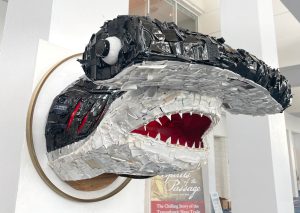
Spending any amount of time on Gulf Coast beaches, you’ll find trash mixed among the sand and shells. Sometimes the sources is laziness and irresponsibility by visitors, but just as often it’s benign neglect—a child forgets their toy while playing along the shore, or picnic supplies blow away from a windy gust. No matter the source, trash is a constant problem on our beaches.

Besides being unsightly and gross, trash in these open areas poses many dangers to wildlife. In my time in the field, I’ve wrestled Ziploc bags away from pelicans and witnessed sea turtles and large shorebirds tangled in fishing line. Some of these animals we managed to rescue—for others we arrived too late. Those common plastics like bags and fishing line are problematic for obvious reasons, but even more insidious are when hard plastics break down into very small, even microscopic-level pieces, and become microplastics. Along with plastic fibers from dry-fit clothing, these tiny particles show up in stormwater, surface water, and even municipal and bottled drinking water.

While the jury is still out on the specific long-term impacts to human health from ingesting microscopic plastics, research is showing the toll they are taking on fish and invertebrates lower in the food chain. These organisms may ingest microplastics instead of real food sources, which can make them feel “full” but leaving them undernourished and starving.
 In the 80’s and 90’s, an effective public awareness campaign about the adverse effects plastic 6-pack rings can have on wildlife still has us Gen X-ers cutting them up before discarding. Now, one beer company has even developed a biodegradable, edible version of the 6-pack ring that is safe for wildlife. These days, creative folks are still trying to raise awareness about the dangers and ubiquity of plastic trash. This week at a conference in Mobile, the Convention Center is full of art installations created wholly from discarded and recovered trash. Repeated patterns in the art include wildlife—impacted most directly by the trashing of habitat–and cigarettes, the most commonly found item in beach and community clean-ups.
In the 80’s and 90’s, an effective public awareness campaign about the adverse effects plastic 6-pack rings can have on wildlife still has us Gen X-ers cutting them up before discarding. Now, one beer company has even developed a biodegradable, edible version of the 6-pack ring that is safe for wildlife. These days, creative folks are still trying to raise awareness about the dangers and ubiquity of plastic trash. This week at a conference in Mobile, the Convention Center is full of art installations created wholly from discarded and recovered trash. Repeated patterns in the art include wildlife—impacted most directly by the trashing of habitat–and cigarettes, the most commonly found item in beach and community clean-ups.

Locally, Our Corner (formerly Keep Pensacola Beautiful) hosts an annual art contest/exhibition called “Pieces Adrift” which features artwork created from trash. The event is a fundraiser, with art pieces auctioned off to raise money for the organization. While this artwork is incredible and fascinating, ideally the end goal is to have so little trash in the ecosystem that it would be nearly impossible to find enough to make art with it. A lot of organizations work with volunteers to remove trash from the environment, including Ocean Hour, Our Corner, and the Pensacola & Perdido Bays Estuary Program’s Trash-Free Waters effort.
It’s not enough just to keep picking it up, though—it is imperative that we reduce single-use plastics and work with individuals to reduce, reuse, and recycle waste. We must also work with corporations to continually find ways to reduce waste in the production, distribution, and retail space so fewer plastics enter the system in the first place. New fabrics and materials made from sustainable sources like bamboo, oyster shells, and trees are in the market, and recycled water bottle clothing is available as well. Keep an eye out for and support organizations doing their best to reduce trash in our ecosystems—all of us will be better in the long run for it.
 2
2
